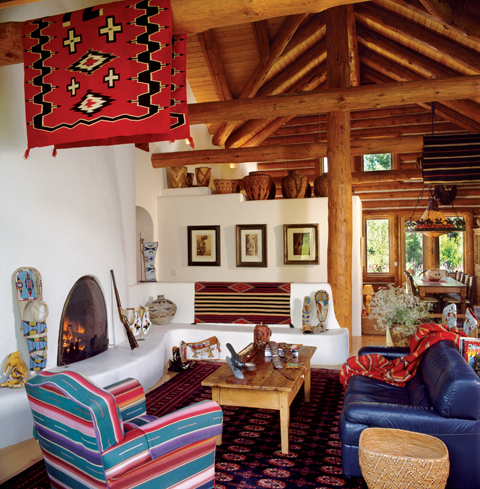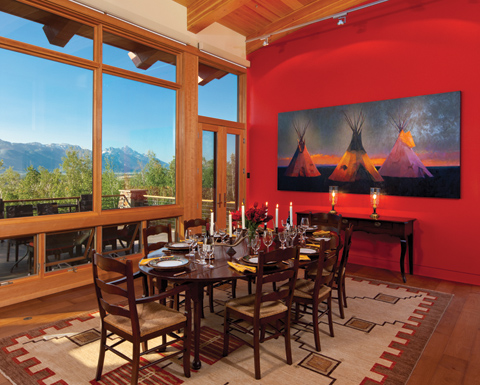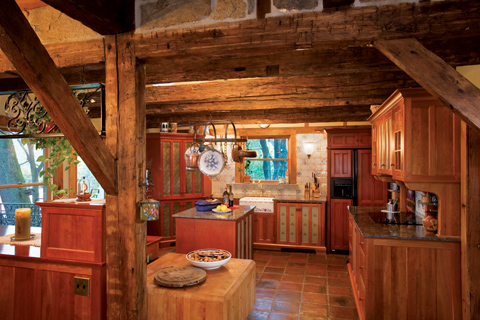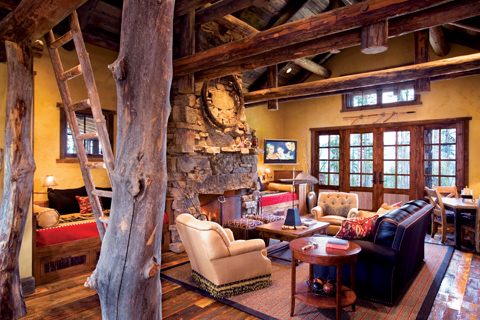Are cowboys and Indians and ranches and cattle the first things that come to mind when you think of Western style? It encompasses all of these things and so much more. Western style incorporates the Spanish, Mexican, Scandinavian, and Asian cultures brought to the American West by its many immigrants. Settlers who moved from the East to the West brought their own styles with them: Adirondack, North Woods, Arts & Crafts, Mission/Prairie, Victorian. Western style reflects the melting pot that is North America.
Like log and timber frame homes, Western style begins with natural, organic materials. It provides a connection with the past and celebrates the land. It is comfortable and functional and provides a respite from technology and urban living.
Setting the Stage
Log and timber frame structures already lend themselves to Western décor, but there are a few things you can do at the design stage to accentuate your style.
Any style of logs provides a beautiful backdrop for Western style. To add to the rustic appeal, consider using reclaimed wood with all of its imperfections as ceiling timbers and window and door trim. Decorative or functional metal strapping on the logs or ceiling structure adds another texture to the interior. Character logs, which retain the natural shape of the tree, can be used as decorative or structural supports, window frames, staircases, and in many other creative ways. They add to the natural, organic look that is a foundation of Western style.
The fireplace is the center of the home and often the major focal point of a great room. The more rustic the fireplace looks the more it ties in with the basic ideas behind Western design. Ideally, fireplace stones should appear as if they were picked up around your property and stacked—in fact, many people do harvest stone when the property is excavated for the foundation. The stones should be of random shapes and sizes, and if a little moss remains on the surface, that’s a real plus! If a natural stone fireplace is not in your budget, many cultured stone manufacturers are able to reproduce the rough stone you are looking for.
 Photo by Roger Wade Studio
Photo by Roger Wade StudioA wide or raised hearth with space for storing logs will give your fireplace more presence in your great room. The early settlers in the West did most of their cooking in the fireplace (or outdoors), so adding a rotating arm and cast iron pot to your fireplace will evoke the past and add interest to the hearth. Or look for some simple, functional iron fireplace tools for the hearth, accompanied by a decorative metal screen. Adding a mantel of reclaimed wood, a half log, or even a large stone will provide a surface for artwork and give the fireplace an extra layer of texture and rusticity.
All of the walls in your log or timber frame home do not have to be wood. Many people choose to break up the wood with sheetrock because it is easier to hang artwork and because they want to add some accent colors. Stucco or Venetian plaster can be custom mixed in a variety of colors that evoke the outdoors and can be applied with as much or little texture or pattern as you desire. Neutral, natural colors will best complement and accentuate the beauty of your logs. You can go bolder with a painted accent wall with colors from orange to navy to dark brown to forest green—colors that bring to mind a sunset, the night sky, rich soil, or a pine tree.
Another important consideration in Western style is flooring. If you select hardwood floors for the public spaces or for the entire home, consider using a wide-plank, hand-scraped wood that looks anything but machine made. A wide variety of choices are available in different price ranges. Reclaimed hardwood, with its knots, nail holes, and other imperfections, is another great choice. If you want to bring the Spanish or Mexican side of Western décor into your home, Saltillo tile will blend beautifully with the wood. It is the warm colors and handmade quality you’re looking for in tile, so it doesn’t need to be authentic Saltillo. Many people prefer wall-to-wall carpet in bedrooms, recreation rooms, and other areas of the home. Look for carpet with a good texture in a color that evokes nature; it will set off all of your furniture and decorative items.
Bringing Western Style to the Kitchen
These days, the kitchen is usually a major part of the great room, so it is important to carry your Western décor into this important space. Wood choices for cabinetry range from reclaimed to barn door styles to painted and distressed. You are aiming for something that looks natural, lived in, and warm but is also practical and easy to maintain. Cabinetry can be custom made to your exact specification, but manufacturers offer a vast choice or woods and finishes that are equally suitable. Adding wrought iron or copper hardware to the cabinets brings another layer of texture to the space.
 Photo by Karl Neumann
Photo by Karl NeumannMetal is an important element in Western style, but you’ll want to stay away from shiny chrome, brass, or stainless steel. Instead, consider a copper or antique bronze range hood, sink, and faucet for the kitchen.
Granite
countertops are an ideal choice for the Western-style kitchen. There are so many beautiful, natural colors and patterns available to fit almost any budget. Rather than having the manufacturer shape and polish the edges, consider leaving a natural edge for a more rustic feel. Wood, also with an unfinished edge, may not be ideal for all of your countertops, but it can be used for a breakfast bar or island in your kitchen.
The backsplash is a great place to let your creativity and flair for decorating shine. The choices are endless, from natural stone to Mexican tile to handmade tile to tin and on from there. If you have chosen an all-natural palette for your kitchen, stone or copper would be ideal, but make sure you take the other elements in your kitchen design into consideration. Mexican tile will add pattern and color to a room full of solid planes of neutrals; it can be used for the entire backsplash or used sparingly as an accent among a neutral field tile. If you want to bring the outdoors into your kitchen, consider using handmade tiles with sculpted animals, leaves, or other nature as accents in your backsplash. Another less expensive possibility is to use tin ceiling tiles as your backsplash. Ideally, they should be painted and distressed, or at least have an antiqued finish; the truly adventurous can comb salvage shops and flea markets for old tin tiles.
Furniture: Anything Goes
Just about anything goes as far as furniture in Western design. When the early settlers arrived in the West, they made furniture out of the materials at hand. As the population grew and people became more financially secure, they ordered more expensive, manufactured pieces in Victorian or Mission styles. The main things to consider are scale, simplicity, and texture. Ideally, the furniture should be comfortable and without fussy detail. Fabrics such as leather, suede, tweed, denim, chenille, saddle blankets, or patterned tapestry work the best.
Consider searching local antique shops and flea markets for unique pieces with a lived-in look. Wood furniture with the paint worn off or items made of reclaimed wood will add to the ambience of your Western décor.
 Photo by Roger Wade Studio
Photo by Roger Wade StudioThere are a number of very talented artists and furniture makers who are either reproducing authentic designs or creating their own heritage-quality furniture. One of the greatest influences is Charles Molesworth, who created the iconic leather chairs and sofas in bright reds, black, and tans. Most surviving Molesworth furniture today is in museums or private collections, but beautiful facsimiles are available. If your budget allows, you might want to splurge on a single significant piece for your home.
The Glow of Lighting
Lighting is an essential part of any décor, as are texture and scale. Your choices are not limited to antler chandeliers, real or made of resin, that are frequently used in Western design. You can find authentic or reproduction oil lanterns that have been wired for electricity or fixtures designed to resemble pine boughs that evoke the outdoors. Avoid shiny brass or chrome fixtures in favor of antiqued metals or burnished copper. To achieve a warm glow in your home, look for lampshades made of glass or mica that send out honey-toned light. Even Tiffany lamps made their way into more affluent Western homes, if you are looking to add some color to your room. Lighting made of a variety of materials and in different styles works best in Western décor.
Accessories & Art
Let your imagination run wild when looking for art and accessories for your Western-style home. Again, flea markets and antique stores are great places to find unique items that have history. Also visit local art galleries and craft shows for paintings, sculpture, and other artwork that complements your décor. If original artwork is not in your budget, look for vintage or reproduction travel posters that spotlight your area of the West. Black and white photographs of animals and Western landscapes will also work well. A Navajo rug, or one with a Native American-style pattern, is great for the floor, but it can also be a stunning wall hanging. Perhaps the best form of artwork you’ll have is the stunning view out your windows.
With so many cultures influencing Western design, you can mix and match what you like. There are no hard and fast rules; it’s what ever makes you happy in your log or timber frame home.

